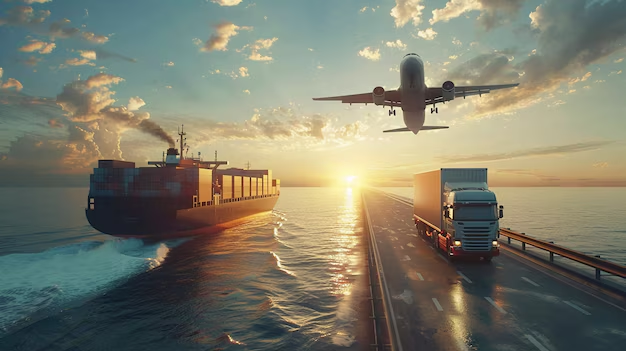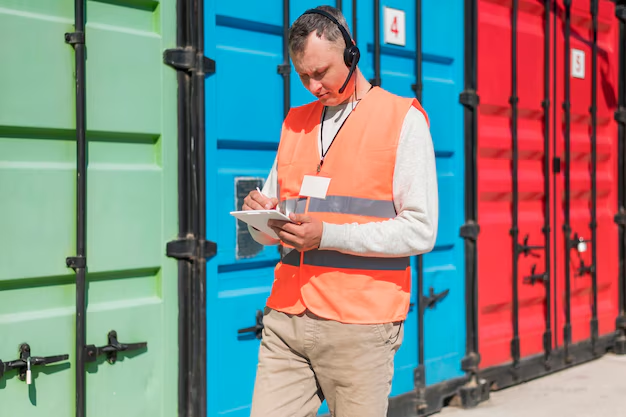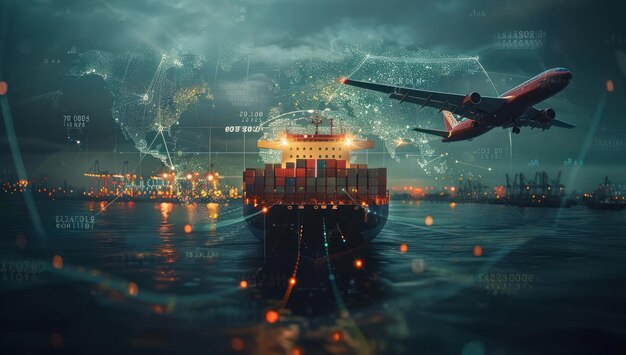
Table of Contents
In this ever-evolving and threatening global scenario, logistics has acquired quite a focal role in the distribution of products at minimum costs.
Since most companies are increasingly seeking growth in the international markets, the awareness of some aspects of the relative freight methods becomes imperative for making sound decisions with respect to general effectiveness and costs.
Among the various means of freight transportation, airfreight is the quickest and the most reliable; hence, it favours goods of importance and those that are perishable.
When compared to other transportation methods, air freight and sea freight are easier to get and transport because the freight services and transportation are mostly very flexible.
It enables foreign trading companies to export their goods at the lowest transportation cost.
Air freight and sea freight are two major representatives of logistics. This utmost guide targets such companies that are in need of making a choice concerning which logos are practical. These include cost effective to appropriate for various types of cargo.
What are the important distinctions between Air Freight and Sea Freight?

Air transport and sea transport relate to whether there is a change in location or movement of people or goods and the time taken for each transit.
In air freight, the movements of cargo are done at high speed by use of air planes, and mostly, the delivery duration takes 1 to 3 days.
This velocity is very important for shipments that have a time-sensitive degradation process, for example, electronics and pharmaceuticals.
On the other hand, Air freight and sea freight are also used in intermodal containers. Still, this time, it is exclusively on the decks of the cargo vessels and usually takes long weeks to arrive, depending on the distance and the sailing path taken.
Yet another difference is cost. One such assessment of total transportation costs that differ is the fact that air freight can relate to extremely high costs when compared to sea freight, the main reason being the fuel costs, aircraft operation costs, and the nature of service offered.
Air or sea transport has its advantages in bulk reversing heavy weight considering what type of cargo should be moved and transported as cheap air freight and sea freight would be suitable.
Furthermore, the type of cargo equally determines what is to follow. For high-value and low-volume shipments, there is airfreight, and for lower-value items in bulk or warehousing, there is sea freight.
This holds with respect to air and sea carbon and pollution minimization: air cargo emissions are more than sea cargo emissions, and therefore, it is recommended to minimize the use of air transportation for such air freight and sea freight.
A strategic approach should be observed in the case of air freight options due to the sensitivities of the cargo involved.
This is usually the case when time is of the essence in the business, as there might be some products that must be delivered within certain timelines, such as a deadline or the arrival of highly valued products.
Another instance where air freight is excellent is in sectors that rely heavily on a just-in-time inventory system.
In the courses of manufacturing or retailing businesses, everyone is racing against time and not meeting the set time will mean a loss. Such consideration is where air freight freight can be managed to reduce such risks.
That is why each institution is going to have to analyze its budgetary constraints and make a decision whether the fast moving goods’ price outweighs the costs incurred.
There are such products as electronics or medical products that are needed very urgently and also need the extra speed that air freight can offer.
Summing up everything, airfreight is not only costly, it is also good and reasonable in terms of value for money only if time and inventory control and the type of cargo carried warrants spending the cash.
Why do businesses choose sea freight over other shipping methods?

This is especially the case when corporations need to iterate transportation through boundaries and transport basic commodities in bulk to distant regions.
The first reason for this is the reasonable price. Judging from all the costs, sea transport is much cheaper than air transport when bulk items such as coal are being transported.
This makes sea freight all the more advantageous, especially to the manufacturing, agriculture and retail businesses where there is a need to transport an unlimited quantity of goods at low cost.
The construction and food industry also transports perishable items by sea after a certain period. This comprises construction resources, equipment and retail items that do not require the rush to be airlifted in the air.
Certain goods that can be bulky or heavy are best transported through sea freight as well. For instance, lightweight air cargo, as the name suggests, is limiting, but cargo ships are more accommodating for heavy materials that would be affordable by air transport.
Also, it can be safely assumed that water transport does not have so much limitation on the volume of cargo as air does.
Last, if an organization is interested in translating its desire, then any belief about carbon footprint reduction will be about sea freight superiority.
This category of transportation has less in comparison to air transportation. In short, sea freight is the best logistics solution when/fixed costs, volume, and type of cargo fit the requirements of a specific business.
What Are The Expenses Related To Air And Sea Freight Transportation?

Regardless of the chosen type of transportation, it is fundamental to figure out the costs associated especially when dealing with air and sea shipping in the course of the planning and execution of any transportation.
If one chooses to go with such air service, a few things need attention, mostly cost structure. Typically, and the airline.
here are other daunting things to do that are above and beyond the normal, which implies fuel taxes and surcharges, security and Customs taxes, and clearance rates, which make the overall costs very much exaggerated.
However, with reference to the costs of sea freight, it is evident that the expense breakdown is much easier.
The main cost that arises in this case is the freight charge, which one gets as a function of the space in cubic meters or weight (in tons) of the cargo shipped.
The minimum lump sum considers that air transport is more expensive and the cost base is rather low.
Because of the lengthy execution of sea freight, the businesses are also going to incur the cost of storage for the inventory if there is prolonged waiting at the port.
When selecting speeds for their business purposes, companies should analyze cost factors in depth in deciding between an air and sea mode of transportation.
Airfreight business can be useful since the customers can be served quickly. Nevertheless, it has its constraints in terms of cost for all items shipped.
Sea freight’s contribution to the overall shipping cost is less, but it is constrained by time factors and other expenses that can affect the profits.
Looking at all the parameters as far as cost is concerned, it would be easy to pick a shipping means that conforms to the prices and the operational ins and outs.
What Are the Customs and Regulatory Issues in Air Freight and Sea Freight Investigation?

As far as air freight and sea freight are concerned, it cannot be overemphasised that there are customs and regulatory issues. Learning and mastering such issues are important for making sure that the goods are delivered in good time without violating any(rule) in any country.
Regarding air freight issues, the speed of movement of the goods, in this case transit, implies that customs clearance has to be expeditious.
During the process of transit of the shipments, it is likely that some inspections would be required, and if they are not carried out, certificates of origin and packing lists so as to conduct the necessary imports or exports and avoid occurrences of shocks in business.
There are concerns with the customs clearance of sea freight as well. There could be an increase in the level of inspection at the port of entry because of delays in travel.
This implies that business organizations will operate on particular import and export regimes, depending on the nature of the goods involved.
Import policies are more or less actualised by some specific countries, including the tariffs policy, tax assessment and the import volume anticipated, hence the need to understand the key policy issues.
Failure to meet these conditions could result in delays that may be costly or even total loss of the commodities involved.
Air and sea freight can also be performed in countries of customs without the need for Kenyans. However, this is a risk on the side of conducting business, especially when it comes to international trade.
This step of the transaction can also be done utilizing some kind of technologies, such as employing the systems of tracing transactions by means of digital devices and rapid movement of customs clearing houses.
To summarise, it does not matter what means of transportation you choose for either this or that case. You still need to know the rules and regulations as such while conducting international trade since they impede the movement of goods from one country to another.
FAQ’s
What stands out primarily about air freight and sea freight work practices?
Speed and expense on the cargo and air carrier services are the very first factors proving the difference between the two modes of transport.
How does air freight fit into sea freight operations?
Use of air freight is appropriate for time bound shipments, high value or perishable items which have to reach the final destination in the shortest time.
What items are suitable for sea transportation, and what are such items in bulk?
Sea freight is efficient for shipping bulky or high-volume goods such as raw materials, machine components, and non-perishable goods. This is more advantageous when transporting heavy goods over long distances.
What are the effects of customs regulations on air and sea freight?
Customs regulations affect both methods by necessitating proper documentation for customs clearance.
In the instance of sea freight customs, there may be a need for greater scrutiny ashore in the ports on internal cargo movement as it involves the need for transportation networks.
Coclusion
As for air and sea freight, one mode of transport cannot fully support trade; continuous switching between the two across more than one border by a company is a tough call in logistics.
The transport mode of choice will have to be air freight, which is not only quicker but has a high level of reliability as well. This is further enhanced by the provision of servicing goods that are time-sensitive and of high value.

